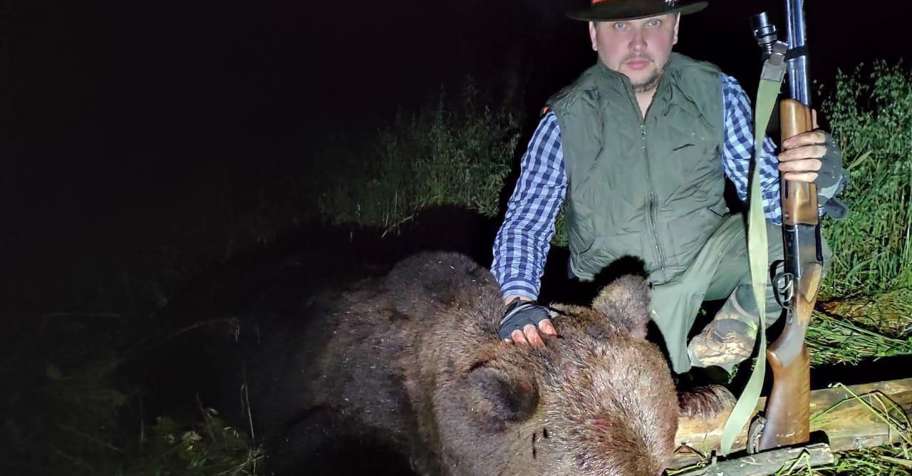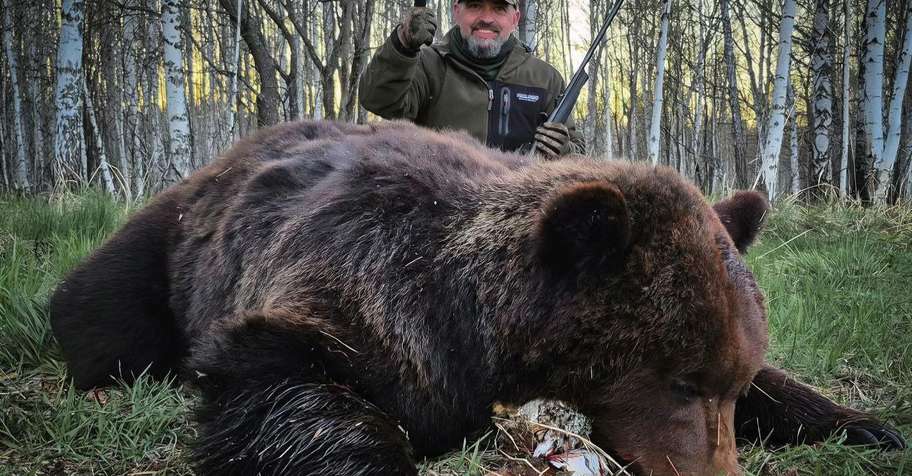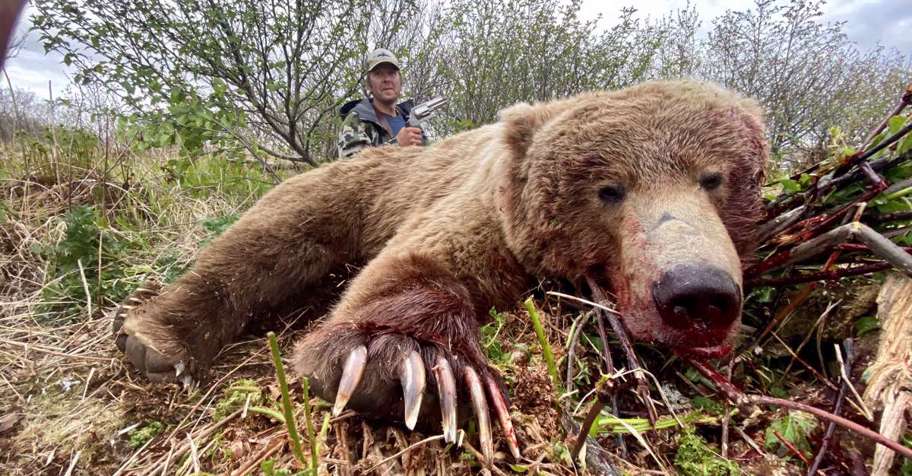
78
hunting trips
€1,167
starting from
40
outfitters
About Brown Bear hunting
Brown bear, a.k.a. grizzly (genetic studies confirm it is the same species) historically occupied all temperate climate zones in Europe, Asia and America. Habitat loss and conflicts with humans have dramatically reduced its range. With the future of grizzly hunts in the Lower 48 still uncertain, the only two areas in North America that offer brown bear hunting are Alaska and Yukon. Russia is the prime alternative for an American who is looking for affordable bear hunting opportunities. Other countries where brown bear season is open include Estonia and Croatia.

Where to hunt Brown Bear
Brown bear, a.k.a. grizzly (genetic studies confirm it is the same species) historically occupied all temperate climate zones in Europe, Asia and America. Habitat loss and conflicts with humans have dramatically reduced its range. With the future of grizzly hunts in the Lower 48 still uncertain, the only two areas in North America that offer brown bear hunting are Alaska and Yukon. Russia is the prime alternative for an American who is looking for affordable bear hunting opportunities. Other countries where brown bear season is open include Estonia and Croatia.
Price distribution
The most affordable brown bear hunts are to be found in Russia. Actually, the prices are so low that many people find them suspicious - you can fit the price for a brown bear hunt, travel exclusive, in the European part of Russia in $2,000 (read the blog story that explains how it’s possible). Prices grow along with average trophy size as you move eastward, and are just over 10,000 for the legendary Kamchatka bruins. The prime trophies and well-equipped outfitters for brown bears in the USA (Alaska), especially on the famous Kodiak island, and Canada (Yukon) command premium prices as well.
€1,167
€12,609
€24,051
€35,493
€46,935
A Bit on Bears: Diet, behavior, and distribution of the Brown Bear
The brown bear is an amazing animal in more ways than one. To begin with, it can boast of one of the largest and more varied distributions of all big mammals. Until human civilization began its triumphal and disastrous march, the range of the brown bear covered all of Europe, almost all of Asia, most of North America and even the north of Africa. In fact, even 200 years ago the Atlas brown bear roamed the mountains of Algeria, Tunis and Morocco, and 100 years ago there were grizzlies in California and in Mexico all the way up to the tropical jungle belt.
Sep 20, 2020
A Bit on Bears: Diet, behavior, and distribution of the Brown/Grizzly Bear
When to hunt Brown Bear?
There are two main seasons for bear hunting: in spring, after the bruins leave their dens, and in the fall, before the denning time. The former runs in March to May, the latter - August to October. Both seasons are similar, in that bears feed actively, in order to accumulate enough fat for the denning, or to compensate for calorie loss during winter sleep, and concentrate around preferred food sources such as salmon runs. In addition, less dense vegetation makes it easier to locate a bear and estimate its size. But different feeding strategies employed by the bruins call for different hunting methods.
Jan
Feb
Mar
Apr
May
Jun
Jul
Aug
Sep
Oct
Nov
Dec
Hunting methods
In the USA and Canada the most common way of hunting brown bear is spot and stalk, especially on salmon runs when bears feed on the fish. The same way is practiced on the other side of the Pacific, in Kamchatka. In Europe most bears are hunted over bait. Russia offers the widest variety of hunting methods, including hunting with laika dogs (the hunters stalk the bear while dogs keep it at bay), hunting from improvised high seats placed where bears plunder oat fields, and hunting bear raised from its den (no, one doesn’t kill a sleeping bear in the den).
Meet your guides
Check out what outfitters have to say about their properties and hunting experience with them!

Bob Cusack
Nestled on the Alaska Peninsula between Lake Clark National Park and the Katmai National Monument is the Cusack's Alaska Lodge. The lodge sits 200 miles to the southwest of Anchorage amid the beauty of wild Alaska. Your hosts are Bob and Lula Cusack, who built the lodge. Bob is a professional grade bush pilot and has been flying fisherman to remote locations for nearly 40 years. This is a rustic, luxury lodge that blends the best of wild Alaska with the best of modern society.

Alisha Mutts Decker
United States
With over 40 years of guiding experience in Southeast Alaska and Glacier Bay National Park, We are an exceptional choice for your next hunting adventure in the Alaskan wilderness. We were formed in 1974 by Master Guides Jimmie C. and MaryAnn. Over the years, the business has grown to be one of the largest professional Guide/Outfitter operations in the State of Alaska. We are a family-owned and operated, with Master Guide Mutts and Zach carrying on the outfitting tradition.
Bush TV
Check out an amazing footage from outfitters and landowners properties.

It is hard to get up
Oh boy its is very hard for this Bear to get up!

Bear search in Snow
This Bear is hard at work looking for something in the snow

Scratch my Back
This bear has a really bad back itch!

Yawning Bear
This Bear must have had a late night

Massive Brown Bear
Massive Brown Bear standing in the rain

Bear Snacking
Bear enjoys an afternoon snack

Bear eating grass
Beautiful brown Bear strolling about and eating grass

Bear fishing for Salmon
This huge Brown Bear is fishing for salmon in Alaska with Full Scope Outfitters

Brown Bear eating lunch
Amazing footage of a Brown Bear enjoying lunch in the water

Curious Shiras-colored Brown Bear
This Shiras-colored Brown Bear really wants to know what is going on and who is looking at him

Brown Bear
Brown Bear giving himself a fright at a feeding site

Brown Bear run
Brown Bear running away from a drone

European Brown bear
The brown bear is the largest land predator on Earth and are quite often a little ill-tempered. These European brown bears are no exception to that.

Alaska Brown bear
The Alaskan brown bear is the largest land predator on Earth. One reason for the exceptional size of these bruins is the plentiful supply of fat and protein in the form of salmon in Alaska's rivers and streams. Here's an up close and personal look a hunter got of this ritual for survival!

Kamchatka Brown Bear in snow
In terms of brown bear hunting, Kamchatka is like Alaska, only twice as remote and twice less expensive. Compare the prices for Kamchatka bear hunts to Alaska coastal browns, and see for yourself.

Kamchatka Brown Bear
Big Kamchatka Brown Bear playing with his food, not afraid that it might swim away.
Why hunt Brown Bear?
Since the dawn of times, bears and humans were two similar, intelligent and omnivorous species that competed for the same environment and food sources. No wonder the idea of bear hunting still makes people very emotional, on both sides of the hunting debate. It is these primal emotions that make hunters go find bears, not the prospect of a big rug or entry in the trophy book. This said, bear meat (where it is not infected with trichinosis) is a delicacy. Brown bear hunting is dangerous game hunting, so be sure you’re packing an adequate rifle and load combination, and listen to your guide well.
Spring Coastal Brown Bear Hunt '26
Alaska, United States
Brown bear
Rifle Hunting, Stalking
Season: Apr 10, 26 - May 10, 26
Package price
€25,173
for 10 days, 1 hunter
Online payment

Brown Bear
Interested in this animal?
Create a subscription to get offers right to your inbox
You might also like
Explore hunting
trips worldwide
trips worldwide
Direct offers from outfitters
with no booking fees
with no booking fees
Verified reviews
from other hunters
from other hunters


